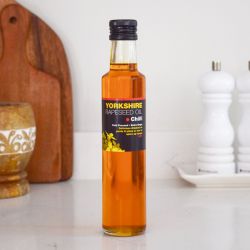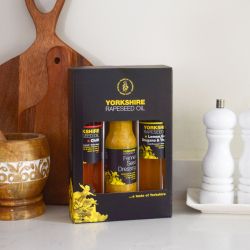Olive & Sundried Tomato Bread
This recipe is from one of our lovely customers, Simon Kelly, who loves cooking with our oils, and sent in a number of recipes as part of a competition. We chose to try and test this one as we're avid lovers of fresh bread and it's perfect for dipping with our Yorkshire Rapeseed Oil with Chilli! Thanks Simon - this bread recipe is a keeper!
Simon's recipe below makes 3 x 2lb loaves, but we made just one by adjusting the ingredients accordingly.
INGREDIENTS
1.5kg strong white bread flour (we used organic flour from J. Stringer & Sons)
900ml water (may need a little more depending on flour strength)
30g salt
30g skimmed milk powder (if you don't have any in the storecupboard, see Our Tip below)
20g dried yeast
20ml Yorkshire Rapeseed Oil with Chilli
1.5 tbsp Yorkshire honey
120g pitted olives, roughly chopped
140g sundried tomatoes, roughly chopped
METHOD
Put all ingredients except the olives and tomatoes into the mixing bowl, with dough hook attached mix for 8-10 mins (until you have a silky, smooth dough).
Oil a piece of cling film and cover the dough with it. Leave to stand for 60 – 90 mins by which time the dough should have doubled in size.
Give it a short mix with the hook to knock it back then add the olives and tomatoes and gently mix through, you may have to finish this process by hand in order to keep whole pieces of olive and tomato.
Divide into 3 or 4 (depending on how big you want the loaves) and form into rounds. Allow the rounds to rest for about 5 minutes. Flatten each round and roll up into a loaf shape then place into a greased 2lb loaf tin. Prove for about 1 hour or until nicely domed above the edge of the tin.
Using a very sharp knife or a razor blade, cut a few diagonal slashes across the top of the loaf, this both looks nice and helps prevent the loaf from splitting. Place in a very hot oven 230oC if your oven can get that hot, for 10 minutes (this kills the yeast off and stops any further rising) then lower heat to 200oC for 15 mins. Check to see if baked, should turn out and sound hollow when tapped, if not give it another 5 mins and test again.
Our Tips
If you don't have any skimmed milk powder, use our tip and replace one third of the water with milk. It still made for a loaf with the perfect crumb!
Simon’s Tips
There is no need to use warm water to start with, the dough temp will rise sufficiently during mixing and first proving.
You do not need to mix the yeast with sugar and tepid water to ‘get it started’
When proving, get a bin bag, put your loaves inside, blow it up to form a tent, then twist the end and seal with a peg or similar. This will prevent your loaves from forming a skin which in turn will help achieve a nice even prove and a good spring in the oven.





